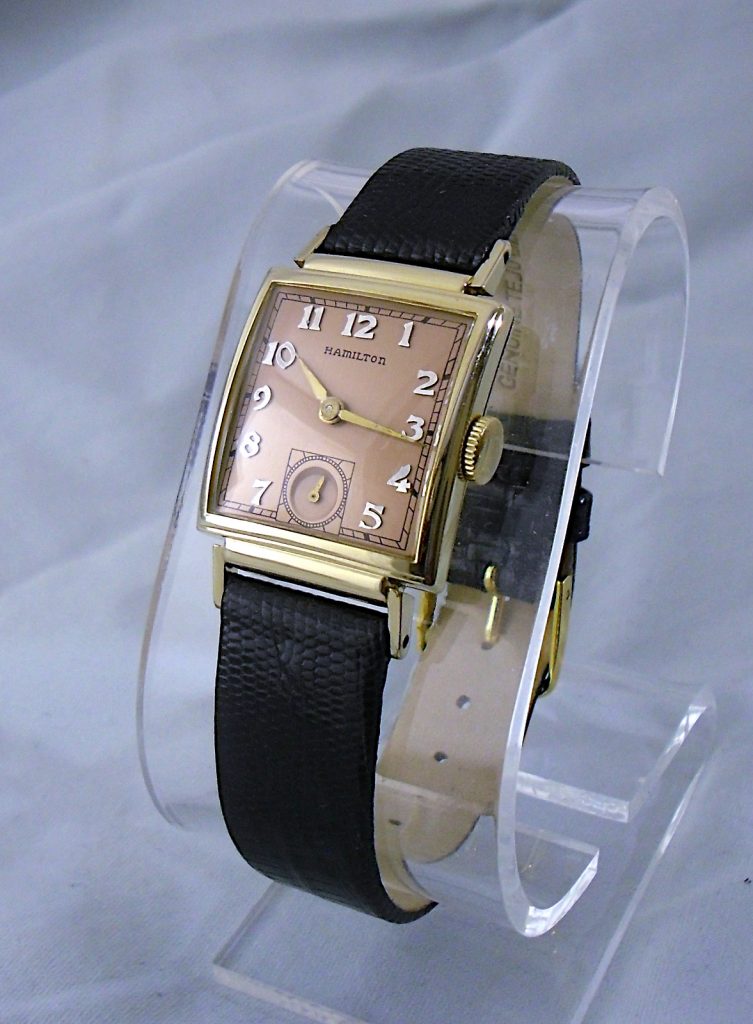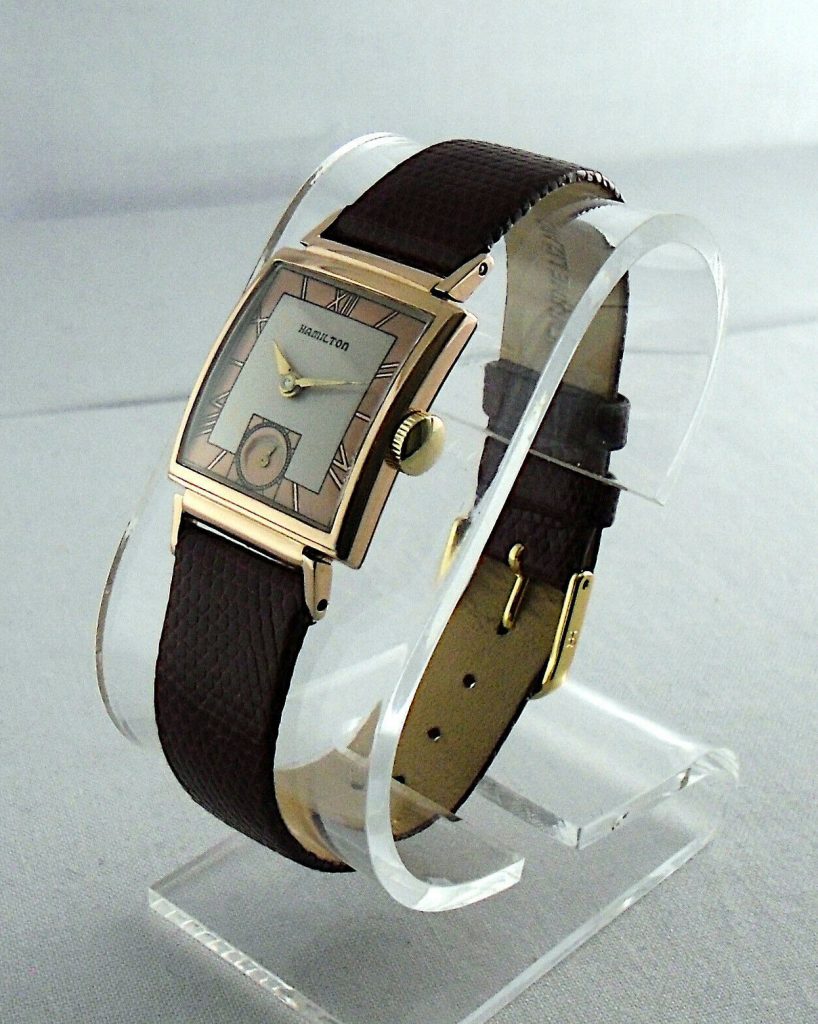You can find Hamilton Ross models on Ebay. I see a few every now and then. The 1945 model with the Butler dial came out when the Company got relief from the War Powers Act of 1941. I think of it as a delayed release like most Hamilton watches that had 980-982 caliber movements produced up to 1952.
While it serves as a good example one of the last watches made by a fully integrated timepiece manufacturer. Little doubt exists that during the 1930’s, Hamilton amased the finest collection of hand wound watches ever produced.
Let’s look at this example from Hamilton’s 1930’s collection of which this model provides insights. The Ross sold out every year, as it fit the budget of moderately affluent customers.

Hamilton’s caliber 982, 19 jewel movement, runs this clock. You can read more about it in the next post. Master watchmakers believe the 982 and 992B pocket watch movements represent the finest hand wound clocks ever made. Many sophisticated collectors will also attest to this assertion.
The 1930 models came with different dial options. Let’s look at a couple.
Some military historians believe that Hamilton gave the allies the ability to win World War II. They make a stout argument when citing the company’s contribution to the ability of the US to thwart Germany’s goals during that confflict. One of the better known summaries, entitled “How Hamilton Watch Co. Won World War II” exists at https://www.jckonline.com/magazine-article/how-hamilton-watch-co-won-world-war-ii/ .
The 982 movement in the Ross model encompasses technical advances made by Hamilton during the 1930’s and early 1940’s and incorporated in their military timepieces.
According to the eBay listing:
“Hamilton made this specific men’s vintage watch during the post-war revival of the US watch industry. All 1945-1952 designs reflect a throw-back to Americanized Art Deco which flourished as the country approached the 1939 New York World’s Fair. Hamilton went back to its 1939 pre-war collection and produced some of the finest stem winding wristwatches ever made by any watchmaker.”
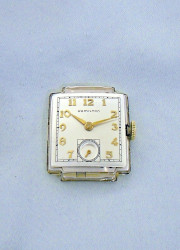
The Case:
Wadsworth manufactured and helped design the Ross case in collaboration with the company’s internal staff and the independent design firm of DiVincenzo & Arienti of New York. As part of the late 1930’s collection, the Ross appealled to moderately affluent buyers during the depression and surprisingly during the 1937-38 recession.

Hamilton sold watches made by four case manufacturers Schwab & Wuischpard, Wadsworth, Fahys and Star. During the 1930’s, the wristwatch group leaned heavily on Schwab & Wuischpard and Wadsworth for design and manufacturering of cases with the independent firm,
Hamilton’s use of the Elinvar alloy made their movements technically superior to both domestic and international competitors. In addition, Hamilton equipped the 982 with materials that allowed watchmakers to tune them to chronometer status.
Dr. Charles E. Guillaume, a nobel prize winning French physicist, developed Elinvar in 1920. Hamilton obtained American rights to Elinvar in 1931 and wrote that they refined the material to produce “the first radical improvement in fine watch construction in 400 years.” Hamilton made their balances with extra elinvar materials.
Guillaume created an elastic, non-magnetic alloy that resisted rust and automatically compensated for variations in temperature and altitude.
Hamilton used it to develop a more advanced alloy.
George Luckey and Ed Shubrooks, Hamilton’s chief metallurgist, developed Elinvar Extra, an uniform alloy that outperformed the material made in Europe. Hamilton produced hairsprings immune to changing conditions resulting unprecedented accuracy.
During the ’30s, Hamilton not only produced watch parts superior in performance to those imported from abroad, they produced them at lower cost.
The main components of the 982 movement keeps the watch running accurately regardless of changes in temperature and altitude. The movement uses Hamilton’s 19 Jewel 14/0 size caliber (mounting diameter of 18.7 x 24.2mm) with a height of 3.4mm. 19 ruby and sapphire jewels, Elinvar hairspring, monometallic balance wheel and alloy mainspring.
Master watchmakers point to Hamilton’s adjustible friction jewels, banking pins, snug collets, balance components, hairsprings and double rollers as elements that allow them to tune the 982 to chronometer level performance.

This 982 movement uses an extra heavy pillar plate, with other plates and bridges using untarnishable precious metal. Hamilton invented and received patents for innovations in escapements and improved friction jewelling related to this watch which became industry standards. This vintage wristwatch has a 45 hour reserve with its new mainspring.
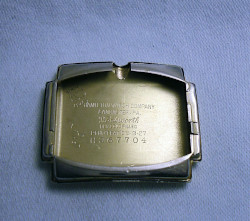
The seller wrote in their listing:
“We thoroughly cleaned, oiled and properly adjusted this movement to reflect steady amplitudes of 320 face up and 265 stem down continuously for 72 hours. Beat rate = 18,000 ph. The mean came in at an average of 0 seconds (in absolute distance from zero) per day, without deviation. We made sure all jewels, pivots, wheels and so forth are like new.”
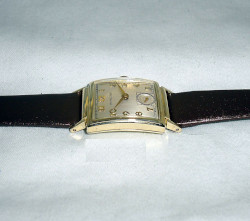
This movement has a serial number of J239375 indicating a production date in 1945.

The face has attached (separate from the dial) 18K gold Arabic numerals contrasting on a silver dial (Hamilton’s Butler finish). The watch appears rarely worn, if at all, which accounts for the consistent rich look. Note the lack of wear around the case manufacturer’s engravings.
Lizard Strap

Specifications:
The Wadsworth case measures 24mm 29 mm with 16mm lugs
Recap:
Hamilton 982 hand wind movement
19 jewels
Movement number
J239375
Case serial number H880989
Original dial, hands, crown and new (original) crystal.
Gold filled case in excellent condition
Movement winds, sets and runs plus accurately over a 45 hour reserve. 14/0 size, Dm= 18.7 x 24.2mm
H= 3.4mm
19 jewels
f = 18000 A/h
power reserve 45h
Breguet hairspring
Hamilton Watch Co. produced watches through a fully integrated process. It began with a master watchmaker who handed off his creation to a protege we might call a machinist today. The protege disassembled the master watch and created specifications for vaious departments within the organization.
Each department had a master watchmaker who made parts which became an element used in the assembly line. Europeans referred to Hamilton’s process as the American Manufacuring System or AMS.
The Europeans had a difficult time converting their entrenched guilds into a smooth manufacturing system. While the Swiss tried to produce uniform watches, they did not officially accomplish that feat until 1984.
During the 1930’s and 1940’s, Hamilton produced watches with superior performance to its competition both domestically and internationally. Hamilton also made those watches for a fraction of the cost of the finest European companies (the Swiss).
The Ross featured in this article provides an excellent example of Hamilton’s achievements.

